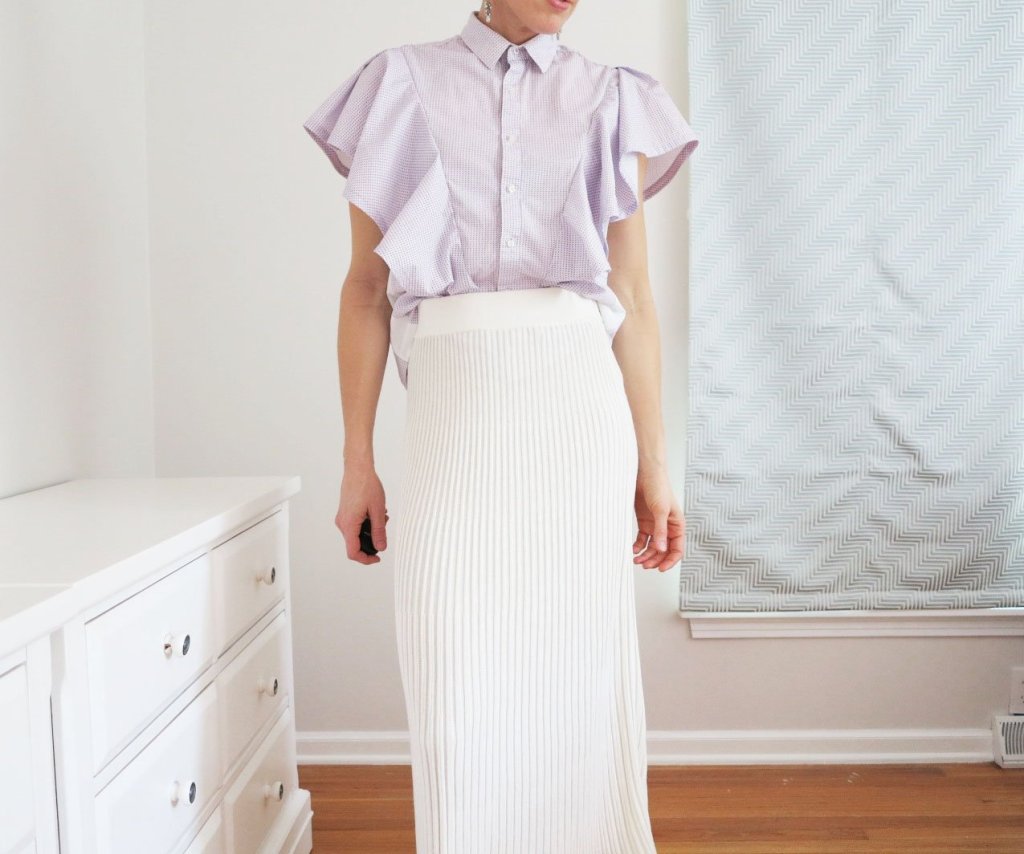It all started with a Sachin & Babi dress that I fell instantly in love with. At that point, I wasn’t truly intending on making a dress, but I couldn’t stop thinking about how I would do it, if I ever decided to go ahead with it. I actually had the most perfect fabric in my stash already, which is rare, because I keep my stash pretty small. Every now and again, I purchase something on whim. It was how I ended up with several yards of the most beautiful sheer silk in shades of green. It will be a special occasion when I finally use it, and hopefully for my eldest daughter, as it was her hair and skin colouring that inspired me to buy it in the first place!
So, using my special fabric was out of the question. But I still couldn’t stop thinking about it. I started toying with the idea of refashioning another Archer in my wardrobe (my other ruffle refashion was an absolute winner!). But then I realised that I had enough of the vintage sheeting to simply start a dress from scratch.
I’d love to say that I had a pattern for this dress, but I made up a lotof it as I went along. It wouldn’t be hard to replicate though. All you need to know is how to make a flounce. You could use any princess seamed sundress pattern.
I started with a self-drafted, princess seamed dress bodice that I often use as a sloper. However, I’ve been doing a lot of swimming over the past year and I’m finding that a lot of my old memades aren’t fitting me so well anymore. My bust measurement has grown by a whole inch, unfortunately not my actual bust, but rather through my side back (the old latissimus dorsi). I ended up letting out the side seams under the arms but keeping the waist measurement the same. It worked perfectly. I also raised the neckline a little and brought the shoulder seams in towards the neck.
As to the ruffles, they are simply flounces that were measured and inserted into the princess seams. It was a little fiddly but perserverence paid off. I love the black insets on the front and back of the bodice, but I have to confess that these design features were the direct result of freestyling my sewing (forgetting a seam allowance) and having to fix the problems. The same happened with the skirt. I ended up recutting several panels more than once. First, I cut the skirt as one, but it didn’t look right without any flounces. So, I seamed it down the front and back but followed the grainline for those seams. As soon as I inserted the first flounce I could see that it wasn’t going to work. I recut the skirt pieces with the seams parallel to the side seams. This makes the flounces fall in a nice bell shape with is prettier than straight lines down the front and back.
This dress is very ruffly! It has a lot of volume through the front bodice and the skirt. I’m fully aware that this is a style that wouldn’t work for everybody. It works well for me. I’m small busted, so the front ruffles add interest and size to the top. My body is somewhat triangular in shape, moreso as I get fitter and stronger. I don’t like emphasizing this shape, so having a bit of added body through the skirt creates the illusion of a more hourglass figure. Sewing is great because you can really play around with design to flatter and create illlusions!
And before I sign off on this dress, I just want to mention a couple of hashtags that I’ve started to use on instagram: #sewingstrong #sewstrong
All body types out there have their own sewing challenges. I can immediately think of patterns that are drafted for bigger busts, for pear shapes, and for petites. I’m not saying one is more challenging than the other, but simply that I have a harder time thinking of patterns that are drafted for tall ladies, small busted ladies, or very athletic shaped ladies. If you know of any, let me know! I would particularly love to know what patterns are working for ladies with broader backs, or strong shoulders. I know that I’ve occasionally turned to men’s shirt patterns, and Thread Theory’s Henley is an awesome fit on me. I’ve also been paying more attention to what Sallie sews lately, because I know if a shirt pattern fits her, it will probably work for me too. I’m hoping that this hashtag will be an easy way to pull up ideas for sewing patterns and flattering designs that work well on a strong female body. If you’re someone who struggles with fitting tops and dresses to a broader than average back, or strong shoulders, jump in and tag along.
















